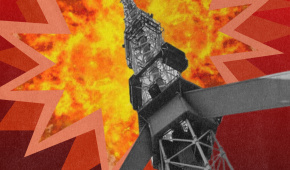Roma, hasidim and minorities that feel beneath others: hate speech in regional media
Ethnic groups and geography or origins were the main objects of hate speech in the regional media in July-August 2021. They accounted for most of the news with hate speech, which was recorded during a sample analysis of regional texts in July-August 2021 *.
Hate speech was also present in gender issues, in the news that discriminated for political views, social status and age.
In most news with hate speech, journalists made allegations of criminality of a particular territorial or ethnic group, accused certain groups of producing negative impact on society, alleged inferiority or moral defficiency of certain groups, mentioned groups or their representatives in a derogatory or offensive context, and contrasted to another group.
At the same time, the number of news items containing hate speech in the regional media has more than three-times reduced, compared to last year. Thus, according to a study in June 2020, in 50 regional online media 87 news items with hate speech were identified. The figures for 2021, we can say, are reassuring. A July-August study of 100 regional media outlets revealed no more than 25 cases of hate speech.
Ethnic groups: allegations of crime and moral deficiency
Most cases of hate speech concerned ethnic groups. During this period, an inadmissible vocabulary was employed against three ethnic groups / national minorities: Hasids, Roma and Georgians.
Thus, news of Hasidim, which contained hate speech, was recorded in two regions : Cherkasy and Volyn. For example, the Cherkasy media reported the following: "A Briton who came to Uman to celebrate Rosh Hashanah will be deported." In fact, the news emphasizes the criminality of the entire ethnic group, forms a negative image of a particular group in society, and contraposes one group to another. The header can be called a classic example of violations of journalistic ethics: it mentions the nationality / citizenship of the offender, his inhering to a certain religious group, as well as a verb with a negative emotional connotation, which can degrade human dignity.
In the Volyn news, the Hasidim lit fires and bought land. Thus, the news " Hasids made fire in Volodymyr Square and cooked food on ", which is based on information from the Telegram channel, asserts about the moral deficiency of a certain group of people and also forms a negative image of this social group. Even more, the text has a blatant manipulation in the headline: if you watch the video in the article, you can see only one person, so any generalizing and speaking of "Hasidim" n the headline is a clear violation of professional standards, which only reinforce the negative attitude towards this ethnic group.
It is worth paying attention to another news item that appeared in the Volyn news and spoke of this ethnic group - "Hasids in Volodymyr-Volynskyi are secretly buying up land?" . This is a classic example of unprofessional journalism that violates the basic standard of credibility and reinforces hatred towards an ethnic group.
The whole text is based on rumors, which siad in the text: " Rumors are spreading at the town saying that members of this Jewish community have become active in Volodymyr-Volynskyi, buying as much land and private houses as possible " or " Rumors are also spreading about the prince that the representatives of this religious community have been keeping eyes for the premises of the infectious disease hospital since a long time . " Such publications oppose one group to another, and also quite directly claim that this group creates inconvenience for the existence of another.
No less questionable is the news concerning the Roma. Thus, several texts about Roma published in the Kherson media had a number of manipulations and violations of professional standards. As, for example, this: " In Kherson, girl passed on all parents’ savings to a gypsy woman" . There are some evaluative judgments such as "Theseis is children and the elderly who are the favorite victims of the Kherson rogues," and speculation about "a woman who looks like a gypsy, " who "made head spin" to a 15-year-old girl, and the latter allegedly gave her parental savings of $ 18,500, and lack of a source of information. And if at first in the news the potential malefactor "looked like a gypsy", then in the next paragraph it was a" gypsy "who disappeared with the money and jewelry that the girl gave her in exchange for a promise to lift the" mythical curse off". The text violated most professional and ethical standards of journalism. Apurtenance of a person to some ethnic group cannot be newsmaker. Evaluative judgments cannot be used in the news. News cannot be published without any reference to the source or the source is unreliable. One cannot emphasize at ethnicity of potential or actual offenders. The Roma cannot be called “gypsies” after all.
It seems, some Lviv media are unaware of these basic principles. Like that article " In Kyiv, Roma threw stones at a train. A video appeared ", in which journalists openly incite hatred. The source of the news was, among others, a post from the social network "Kyiv Operative". Journalists immediately emphasized in the headline that they were Roma who threw stones at the train. The photo to the news depicted children of this ethnic group showing their middle finger. The selected photo seems to reinforce the idea that this ethnic group is aggressive and cruel. In the text itself, the sentence "Wacky people put a tree on the railway line" attracts attention. This is not just an evaluative judgment of journalists, which cannot be used in news items. This is an allegation of inferiority, an emphasis on the moral deficiency of the ethniuc group, as well as its positioning as a source of threat, including allegations of criminality.
Classically, the hate speech, namely the allegation of criminality of a certain ethnic group, includes some national minorities, which are still called "Caucasians" in the media. Usually, this fictional ethnic group includes media representatives of Georgian, Armenian and Azerbaijani nationalities. Odessa media outlets had violations of these standards. In particular, the news " Shooting at Malinowski street: police named killer and revealed details of murder " refers to a high-profile contract killing that occured recently in Odessa. Despite the fact that the report mentions several surnames belonging to different nationalities, the author clearly pointed out at the origins of a Georgian suspected in the murder. The same is seen in the news "The identity of the alleged killer who shot down a man in Odesa established . " Sucn news items have hatred speech based on ethnicattributes of a person, since they assert some ethnic groups are inclined to commit crimes, which is inadmissible in terms of journalistic standards.
"Donetsk" and allegations of crime
The Kherson media used the rather popular cliché on "Donetsk crime circles". For example, in the text " 30 MPs suggested to impose sanctions against" Donetsk mafia "in the Kherson region " the author put an ideologeme about Donetsk origins of mafia in inverted coma, manipulates with the idea of the Donetsk origin of the politician and points out that, in his opinion, " special sanctions against" Donetsk "crime in Kherson region will be imposed. "
Another news item in Lviv media is of the same kind "Apologies are not enough, he ought to be placed in prison for doing this ": in Mariupol, a young man demonstratively set fire to the flag of Ukraine, and later apologized . " On the one hand, there is a specific fact with signs of a crime on the other hand, such news may foment the idea about betrayors of the nation, that the inhabitants of the east of Ukraine can love their country less or not love it at all, disrespect its national symbols. The author wrote a phrase “ A rustic from Mariupol decided to set fire to a flag of Ukraine”. This sort of phrase that journalists should not use in texts at all, positions the group, its representative in a humiliating, offensive context.
The hate speech which is applied on the basis of geography or origin can be seen in the publication "Near Dnieper, displaced persons beat administrator of quarter. Mayor promised to expel its residents" , which was published in the media in Dnieper. It is about the row in the modular quarter at Pavlograd for temporarily displaced persons, caused by debts for utilities. Moreover, there is no balancing comment of the representatives of the modular quarter in the text, but a statement of the mayor of Pavlograd, which is in fact a direct assertion saying that one group creates inconveniences in the existence of another and is a source of threats. The text also contains allegations of moral deficiencies and criminality of the group as a whole.
All these are classic examples of hate speech, which in a negative context speak of people from a certain region and which with the beginning of the war became a fairly common negative trend in the Ukrainian media.
Gender and "shame": humiliation and allegations of moral defeiciency
Generalizations, negative evaluations and stereotypes accompany gender issues, which include women, LGBT, sexual orientation. For example, in the text " In the Kherson region, daughter attempted to stab one’s mother " is as follows: "The stabbing is already frequent not only among the stronger sex, but even among the ladies in the Kherson region." Describing the incident, which became known from the criminal records of the local police, the journalist did not indicate the source of information, but instead drew his own conclusions about the "strong" sex and women.
Coverage of LGBT issues still can have the following examples: " In Dnipropetrovsk region , representatives of minoroties came out to a rally: they were protected by police". The text created a negative image of LGBT people and, in fact, had an idea about moral deficiency of the group with the statements like "The most of present minority people there were ashamed to reveal one’s faces, they wore hats, glasses and masks . " In fact, the protesters could wear it due to a sense of danger. The news also uses the phrases like "non-traditional orientation" and "sexual minority", which are also incorrect.
Another article from the Dnieper media "VFree will refusal of one’s children is gaining popularity in Ukraine ", apparently was to speak of child-free people, but even with the several experts commenting it on, the text proposed a widespread statement about the inferiority of women who refuse to have children. This is noticeable both in the personal evaluative judgments of the author and the women experts. Finally, all the material is about child-free women, and it never mentions men.
By the way, about men. The media in Dnipro also recorded sexism against men. In the article " Our male patients are imbeciles": the "Synevo" laboratory got into a sexist scandal " the headline contains a comment of a user who, outraged by the sexist post of a private laboratory on the social network, wrote his own interpretation of their joke. But putting it at the headline only reinforced the assertion of the inferiority of men, and the text also reveaed sexist evaluative judgments, such as "members of the stronger sex."
Politics, insults and calls for violence
Several materials that contained hate speech and should be discussed had discriminative ideas on political grounds. One of the best examples, the text " You went to kill for bucks :led": odious supporter of Zahyd Krasnov got serviceman riled (video) " . He reports on a rally under the walls of city council of Dnipro, which, according to reporters, would be organized by political opponent of the current mayor of the Dnipro. Among other things, the text states: " These are the people who stand behind Zahid Krasnov. The Russian world and hatred for everything Ukrainian came out little by little in the streets from "posts" on Facebook. If we allow to it to exist in comfort, Oleg Tsarev and his дшлуьштвув will rally tomorrow . " Such wording can be seen as a veiled call to violence and opposition of one group to another, in order to use the traumatic political confrontation in Ukrainian society in their own interests.
In general, we can note the pattern in writing news that contains hate speech. They usually violate basic professional standards, in particular rely on unreliable sources or no sources at all, violate the standard of balance of opinions and often have evaluative judgments that are unacceptable in the news. In addition, such texts use incorrect vocabulary, and informational reasons are often ethnic, gender or other personality traits, rather than socially significant events and phenomena, which is a basic violation of ethical standards of journalism.
* The hate speech was analyzed in the media of Dnipro, Odessa, Kherson, Volyn, Cherkasy, Kropivnitsky, Lviv, Kharkiv and in non-occupied part of Donetsk region. 100 regional media were analyzed.
This study was made possible by the support of the American people through the USAID Media Program in Ukraine, implemented by the international organization Internews Network. The content is under the sole responsibility of the Institute for Mass Informatipon and does not necessarily reflect the views of USAID, the US Government or the Internews Network.
Help us be even more cool!



